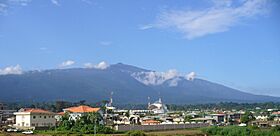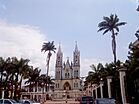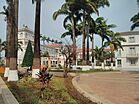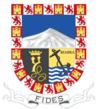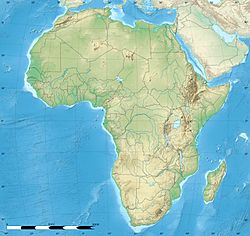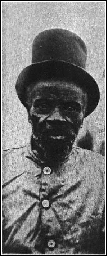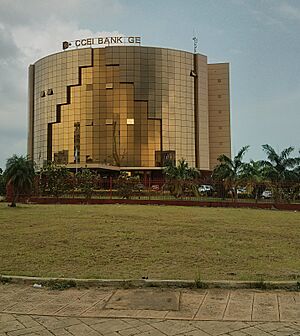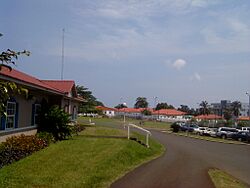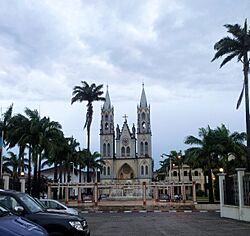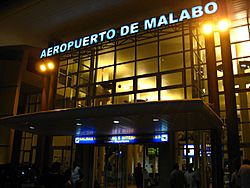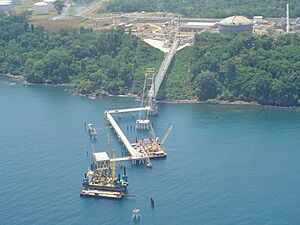Malabo facts for kids
Quick facts for kids
Malabo
Santa Isabel (before 1973)
|
||
|---|---|---|
|
Top: Malabo skyline; Middle: Cathedral of Santa Isabel, Presidential Palace; Bottom: Spain Cultural Center, Bata Waterfront
|
||
|
||
| Country | ||
| Province | Bioko Norte | |
| Region | Insular Region | |
| Founded | 1827 | |
| Current name | Since 1973 | |
| Area | ||
| • Total | 21 km2 (8 sq mi) | |
| Elevation | 0 m (0 ft) | |
| Population
(2018)
|
||
| • Total | 297,000 | |
| • Density | 14,100/km2 (36,600/sq mi) | |
| Demonym(s) | Malabeño-a | |
| Time zone | UTC+01:00 (West Africa Time) | |
| • Summer (DST) | (Not Observed) | |
| Climate | Am | |
| HDI (2019) | 0.710 high |
|
Malabo is the capital city of Equatorial Guinea. It is also the capital of the Bioko Norte province. The city is located on the northern coast of Bioko island. In 2018, about 297,000 people lived there.
Spanish is the official language in Malabo and across the country. However, many people on Bioko island, including in Malabo, also speak Pichinglis. This language helps people from different backgrounds communicate.
Malabo is the oldest city in Equatorial Guinea. A new planned city, Ciudad de la Paz, is being built on the mainland. It is designed to become the new capital. Government offices started moving to Ciudad de la Paz in 2017.
Contents
History of Malabo
European Discovery and Portuguese Rule
In 1472, a Portuguese explorer named Fernão do Pó found the island of Bioko. He called it Formosa, meaning "beautiful". Later, the island was named after him, Fernando Pó. In the early 1500s, another Portuguese person, Ramos de Esquivel, tried to start a colony there. He set up a factory in Concepción (now Riaba) and grew sugarcane.
In 1777 and 1778, Portugal gave the islands of Fernando Pó and Annobón to Spain. This was part of a trade. Spain also got the right to trade in a large area of Africa. In return, Portugal received some lands in South America. Spain was not very interested in these African lands at first. So, in 1827, they let the British use the island as a base. The British wanted to stop the slave trade.
British Presence on the Island
In 1821, a British ship found Fernando Pó island empty. The British decided to set up a base there. On December 25, 1827, they founded Port Clarence. This new settlement was built where Malabo is today. It was named after the Duke of Clarence, who later became King William IV. The local Bubi called it Ripotó, meaning "place of foreigners".
The population of Port Clarence grew with freed slaves brought by the British. These freed people settled there before Sierra Leone became a colony for freed slaves. Their descendants, along with other workers from West African countries, became known as the Fernandinos. They speak Pichinglis, a mix of Bantu, English, and some Spanish words.
During the British time, the British consul acted as the governor. One famous governor was John Beecroft. He helped modernize the capital. Spain later honored his work with a monument.
Spain Takes Full Control
In 1844, Spain decided to take back control of the island. They wanted to modernize their country and reclaim their territories. It took about ten more years for Spain to fully establish its rule. The capital, Port Clarence, was renamed Santa Isabel. This name honored Queen Isabella II of Spain. Santa Isabel then became the capital of Equatorial Guinea.
In 1973, the city's name changed again to Malabo. This was part of a plan by President Francisco Macías Nguema to replace European place names with African ones. The new name honored Malabo Lopelo Melaka, the last Bubi king. King Malabo surrendered to the Spanish. His uncle, Sas Ebuera, continued to fight the Spanish until he was killed in 1898. After that, Malabo became king, but with less power. It took until 1912 for the Spanish to fully control the island.
A Difficult Period
During a period known as the Reign of Terror under President Macías Nguema, many educated people in the country faced difficulties. The government changed, and many public jobs were given to people from the president's home region.
The Black Beach prison, also called Playa Negra prison, is located near the Cónsul River. Many political leaders were held there during this time. These included figures like Rafael Upiñalo and Plácido Micó Abogo.
Geography of Malabo
Malabo is in the northern part of Bioko island. It is located at 3° 45' 7.43" North and 8° 46' 25.32" East. The Cónsul River forms the southern border of Malabo. The city's hospital is just across this river to the southwest.
The Malabo International Airport is about 9 kilometers (5.6 miles) west of the city center. Along the northern coast, there are bays and capes. The Punta de la Unidad Africana is a cape behind the Malabo Government Building. Another important cape is Punta Europa, located near the airport to the west.
Climate
Malabo has a tropical monsoon climate. This means it gets a lot of rain. On average, Malabo receives about 1,850 millimeters (73 inches) of rain each year.
The city has a short, sunnier (but still cloudy) dry season from December to February. January is usually the driest month, with about 29 millimeters (1.1 inches) of rain. The long, cloudy wet season lasts for nine months, from March to November. September and October are the wettest months, getting about 500 millimeters (20 inches) of rain combined.
Daytime temperatures in Malabo do not change much throughout the year. They stay fairly consistent. At night, the average low temperature is around 20 to 21 °C (68 to 70 °F). Malabo is known for being one of the cloudiest and wettest capitals in the world. It also experiences a lot of fog and haze, even when it's not raining.
| Climate data for Malabo | |||||||||||||
|---|---|---|---|---|---|---|---|---|---|---|---|---|---|
| Month | Jan | Feb | Mar | Apr | May | Jun | Jul | Aug | Sep | Oct | Nov | Dec | Year |
| Record high °C (°F) | 34.2 (93.6) |
35.3 (95.5) |
34.5 (94.1) |
36.5 (97.7) |
34.0 (93.2) |
32.5 (90.5) |
31.5 (88.7) |
32.0 (89.6) |
32.5 (90.5) |
32.5 (90.5) |
32.5 (90.5) |
33.5 (92.3) |
36.5 (97.7) |
| Mean daily maximum °C (°F) | 31.1 (88.0) |
31.8 (89.2) |
31.3 (88.3) |
31.3 (88.3) |
30.5 (86.9) |
29.5 (85.1) |
28.4 (83.1) |
28.0 (82.4) |
28.1 (82.6) |
28.8 (83.8) |
29.8 (85.6) |
30.8 (87.4) |
30.0 (86.0) |
| Daily mean °C (°F) | 26.9 (80.4) |
27.7 (81.9) |
27.6 (81.7) |
27.2 (81.0) |
26.7 (80.1) |
25.9 (78.6) |
25.3 (77.5) |
25.0 (77.0) |
25.1 (77.2) |
25.5 (77.9) |
26.1 (79.0) |
26.6 (79.9) |
26.3 (79.3) |
| Mean daily minimum °C (°F) | 23.0 (73.4) |
23.9 (75.0) |
24.1 (75.4) |
23.8 (74.8) |
23.5 (74.3) |
23.3 (73.9) |
23.2 (73.8) |
23.1 (73.6) |
22.8 (73.0) |
22.9 (73.2) |
23.0 (73.4) |
22.7 (72.9) |
23.3 (73.9) |
| Record low °C (°F) | 17.0 (62.6) |
16.5 (61.7) |
15.5 (59.9) |
16.5 (61.7) |
15.0 (59.0) |
18.0 (64.4) |
17.1 (62.8) |
15.0 (59.0) |
18.5 (65.3) |
17.6 (63.7) |
19.0 (66.2) |
17.5 (63.5) |
15.0 (59.0) |
| Average rainfall mm (inches) | 28.9 (1.14) |
70.6 (2.78) |
102.7 (4.04) |
155.7 (6.13) |
227.1 (8.94) |
260.8 (10.27) |
202.0 (7.95) |
177.1 (6.97) |
250.1 (9.85) |
254.3 (10.01) |
100.3 (3.95) |
39.6 (1.56) |
1,869.1 (73.59) |
| Average rainy days (≥ 1.0 mm) | 3.5 | 4.6 | 9.8 | 12.0 | 17.2 | 19.0 | 17.5 | 14.8 | 20.6 | 19.5 | 10.3 | 4.0 | 152.7 |
| Average relative humidity (%) | 83 | 83 | 84 | 84 | 87 | 89 | 90 | 89 | 91 | 90 | 88 | 84 | 87 |
| Mean monthly sunshine hours | 120.9 | 121.5 | 108.5 | 114.0 | 99.2 | 66.0 | 43.4 | 52.7 | 48.0 | 71.3 | 87.0 | 117.8 | 1,050.3 |
| Mean daily sunshine hours | 3.9 | 4.3 | 3.5 | 3.8 | 3.2 | 2.2 | 1.4 | 1.7 | 1.6 | 2.3 | 2.9 | 3.8 | 2.9 |
| Source: Deutscher Wetterdienst | |||||||||||||
City Administration
The mayor of Malabo is María Coloma Edjang Mbengono. The mayor and city government are responsible for many public services. These include providing drinking water, street lighting, paving roads, and managing cemeteries. They also handle cleaning and sanitation, waste treatment, and health inspections.
Past Mayors
Here are some of the mayors who have served Malabo since 1960:
- Wilwardo Jones Níger
- Abilio Balboa Arking
- Antonio Ribeiro Ebuera
- Julio Bonete Eiye
- Julián Ehapo Bomaho
- Vidal Djoni Bekoba
- Tomás Alfredo King Tomas
- Rosendo Toichoa Borico
- Felipe Beta Tobachi
- Antonio Reibeira Ebuera
- Elías Manuel Macho Ricacha
- Basilio Cañadas Idjabe
- Cristina Djombe Djangani
- Vicente Ebong Uwa
- Bernardino Edu Oba
- Victorino Bolekia Bonay
- Gabriel Mba Bela
- María Coloma Edjang Mbengono
- Isabel Eraul Ivina (2004)
Cultural Life
The Spanish Agency for International Cooperation for Development (AECID) supports many projects in Malabo. These projects help develop culture, health, education, and government services.
The Cultural Center of Spain in Malabo (CCEM) was founded in 2003. It's a place where young people can explore their creativity. The center offers activities like training, art, film, theater, music, and games. It also hosts two main festivals: the Traveling Film Festival of Equatorial Guinea (FECIGE) and the International Festival of Hip Hop in Malabo.
Another important place is the Equatorial Guinean Cultural Center. It was built in the 1950s and has served as an archive, museum, and library.
The Museum of Modern Art Equatorial Guinea displays traditional and modern art from the country and Africa. Malabo also has the National Library, which was built in 1916.
Tourism in Malabo
Tourism in Malabo is growing. Since oil was discovered, many new buildings and facilities have been built. Malabo is a key spot for tourism in Equatorial Guinea. It offers easy access to many attractions on Bioko island.
Some nearby tourist spots include:
- San Antonio de Ureca: A small town in the south of the island. It is known for its primates, birds, beaches, and waterfalls. From November to February, you can watch leatherback sea turtles lay their eggs at night.
- Ilachi or Iladyi Waterfalls: These are the country's largest waterfalls, falling over 250 meters (820 feet). They are about a 45-minute walk from the city of Moka.
- Pico Basilé: This is the highest mountain in Equatorial Guinea. It is over 3,000 meters (9,800 feet) high and can be seen from all over Malabo. A church and a statue of Mother Bisila are at the top of the mountain.
- Sipopo luxury resort: This resort was built for the 2011 African Union Summit.
Population of Malabo
| Growth of population of Malabo | ||
|---|---|---|
| Year | Persons | % |
| 1983 | 31 650 | – |
| 1994 | 60 065 | +89.8 |
| 2000 | 73 117 | +21.7 |
| 2007 | 96 000 | 31.3 |
| 1983 and 1994: censuses 2000 and 2007: estimated |
||
Malabo has a fairly young population. About 45% of the people are under 15 years old. Only about 4% of the population is older than 65. Most of the island's population lives in rural areas.
Economy of Malabo
Malabo is the main business and financial hub of Equatorial Guinea. The city's economy relies on government services and other businesses. Trade is also very important, especially since American companies started drilling for oil wells near the coast. This trade also comes from people from other countries like Mexico, Nigeria, and Spain.
The main industry in Malabo is fishing. Cacao and coffee are the main products that the city exports.
Malabo has a large port that can handle many goods. It connects mainly with ports in Douala, Cameroon, and Bata. The city also has an international airport for air travel. There are about 300 hotel rooms available in the city.
Education in Malabo
Malabo is home to important educational institutions. The National University of Equatorial Guinea (UNGE) has a campus here. The National Distance Education University (UNED), which teaches in Spanish, also has its headquarters in the city. The Colegio Nacional Enrique Nvó Okenve, another university in the country, has one of its two campuses in Malabo.
There are also several international schools:
- Colegio Español Don Bosco
- Lycée Français de Malabo
- Equatorial Guinea Turkish International College
- Royal International College
City Attractions
Malabo has many buildings from the time it was a colony. These include the Presidential Palace and the Palace of Justice. Other old buildings can be found downtown, like wooden houses from the 1800s on Nigeria and Rey Boncoro streets.
A famous building is the Cathedral of Santa Isabel. It is a Gothic Revival style church built between 1897 and 1916. The architect was Luis Segarra Llairadó. The church has two tall spires, each 40 meters (130 feet) high. In 2020, a fire damaged part of its structure. Work to restore it began in 2021.
Other interesting places include La Gaditana, the casa Teodolita (built in 1902), the City Hall building, the Church of Elá Nguema, Independence Square, Parque Nacional de Malabo, the Casa de España, and the city's harbor bay.
Transportation
Public Transport
Public buses run between downtown Malabo and the neighborhood of Ela Nguema. Taxis are available throughout the city and nearby areas. You can also rent cars from companies like Avis and Europcar.
Sea Transport
The port of Malabo can handle up to 200,000 tons of goods each year. Ships mainly travel between Malabo and other national ports like Bata. International routes connect to Spain and Douala in Cameroon.
Air Travel
The Malabo International Airport serves the city. It is located 7 kilometers (4.3 miles) from the city center in Punta Europa. The airport offers direct flights to Europe and several African capitals:
- Madrid (Spain): Ceiba Intercontinental (4 flights per week)
- Paris (France): Air France (3 flights per week)
- Frankfurt (Germany): Lufthansa (3 flights per week)
- Casablanca (Morocco): Royal Air Maroc (2 flights per week)
- Istanbul (Turkey): Turkish Airlines (1 flight per week)
- Cotonou (Benin): Cronos Airlines (2 flights per week)
- Abidjan (Ivory Coast): Ceiba Intercontinental (3 flights per week)
- Accra (Ghana): Ceiba Intercontinental (3 flights per week)
- São Tomé (São Tomé and Príncipe): Ceiba Intercontinental (3 flights per week)
- Douala (Cameroon): Ethiopian Airline (3 flights per week); Cronos Airlines (3 flights per week)
- Libreville (Gabon): Royal Air Marroc (2 flights per week)
- Port Harcourt (Nigeria): Cronos Airlines (2 flights per week)
- Addis Ababa (Ethiopia): Ethiopian Airlines (3 flights per week)
From Malabo airport, you can also fly to other airports within Equatorial Guinea. These include airports in Annobón, Bata, Mongomo, and Corisco.
Places of Worship
Malabo has many places of worship. Most are Christian churches, including Catholic churches (like the Roman Catholic Archdiocese of Malabo) and Protestant churches. The Malabo Mosque was built in 2015.
Sports in Malabo
The main sports facility in Malabo is the Estadio de Malabo. It can hold 15,250 spectators. This stadium is the home of the Equatorial Guinea national football team. It also hosted matches during the 2012 Africa Cup of Nations. The Spanish national football team, who were World Champions at the time, played a friendly match here. The stadium is also home to CD Elá Nguema, the country's top football club. Another stadium in Malabo is the Estadio Internacional, which has 6,000 seats.
Equatorial Guinea co-hosted the 2012 Africa Cup of Nations with Gabon. The Estadio de Malabo was one of the four stadiums used for the tournament. Six group stage matches and one quarter-final match were played in Malabo.
On November 16, 2013, the Spanish national football team played a friendly match against the Equatorial Guinea national football team. This was the first time a European team visited the country.
Several top football clubs in Equatorial Guinea are from Malabo. CD Elá Nguema has won the national league title 14 times, more than any other club. Other successful clubs from the city include Renacimiento FC, Atlético Malabo, and Cafe Bank Sportif. Atlético Semu has won the national cup once.
Malabo also has a successful basketball club called Malabo Kings. They won the Central Zone of Africa Basketball Championship in 2013. The Malabo Kings had previously finished second in 2011. In 2013, Malabo hosted a basketball camp organized by the Equatorial Guinea Basketball Federation.
Malabo was originally chosen to host the 2019 African Games. However, due to economic issues, they withdrew, and Casablanca, Morocco, became the new host city.
Discovery of Oil
Malabo has changed a lot because of the oil industry. Equatorial Guinea's oil production reached 360,000 barrels per day in 2005. This led to the city's population doubling. However, most of the wealth from oil has not been invested in developing the city for its people.
International Connections
Sister Cities
Malabo has friendly connections with these cities:
Notable People
- Juan Tomás Ávila Laurel, an author and activist from Equatorial Guinea.
- John Batchelor, a British rugby player.
- Rita Bosaho, a politician and activist from Equatorial Guinea and Spain.
- Elsa López, a Spanish writer and poet.
Images for kids
See also
 In Spanish: Malabo para niños
In Spanish: Malabo para niños


